„In the marketing business today, it's like driving cars backwards. We're constantly figuring out how we can use data and technology to make changes. Because everything is supposedly always changing, today's customer is not the same as yesterday’s,“
says Wiemer Snijders, author of Eat Your Greens and a representative of so-called evidence-based marketing.
But he himself is a proponent of the thesis of the American creative and one of the founders of the advertising network DDB Worldwide Bill Bernbach that „marketers must deal with the unchanging person.“
The same view is shared by Amazon founder Jeff Bezos, whom Snijders likes to quote: „I'm not so much interested in what changes, I focus more on what doesn't change and lasts, say, decades. That's the foundation on which I want to build my business.“ But current trends in marketing go against these claims.
The things we measure in marketing have very little relation to our behaviour and how we shop, according to Snijders. He has collected similar views in his book Eat Your Greens from marketing experts Mark Ritson, Richard Shotton, Byron Sharp and others. The book's title refers to eating vegetables that promote health and help protect against diseases. In a figurative sense, the book is a contribution to evidence-based marketing thinking that helps brands cultivate and improve performance through quality nutrition. „It is in today's changing media environment that we should be interested in how to communicate more effectively,“ Snijders believes.
THE BANANA THEORY AKA NOT APPLE BUT A BANANA
„When you ask people in marketing what they consider a success, many will answer with a single word - Apple. But after the evidence of success that I will present to you, you should no longer think of an apple (Apple), but a banana,“ says Snijders with a bit of hyperbole.
The banana, or more accurately, the banana-shaped statistical formula that describes customer buying behaviour, was first described by Andrew Ehrenberg in 1957. This theory (the so-called negative bionimal distribution) has been further developed and tested by Wiemer Snijders and other marketers over the last six decades.
A LOT MAKES A LITTLE AND A LITTLE MAKES A LOT
This pattern shows that a brand's customer base is largely made up of customers who shop infrequently.
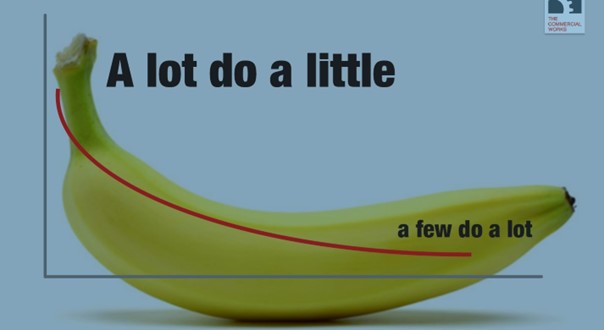 Source: Wiemer Snijders, presentation for AKTV conference 2019
Source: Wiemer Snijders, presentation for AKTV conference 2019But customers who shop often, who are much fewer in number overall, bring in more revenue, as Wiemer Snijders demonstrates with an unnamed soft drink brand. Of the brand's 2 million customers, 20 percent of them brought her 60 percent of the revenue. Nearly half brought in just 12 percent of revenues. This makes it much easier to focus on a group of loyal customers that brings in a significant amount of revenue and think about how to further encourage their shopping behavior.
But when the revenue data is broken down by purchase frequency and total revenue, we arrive at a banana-shaped graph (see chart below). Customers who buy infrequently, i.e. a maximum of 5 times a year or less, come to the fore. They make up the largest part of the revenue and the brand is therefore most dependent on their shopping behaviour.
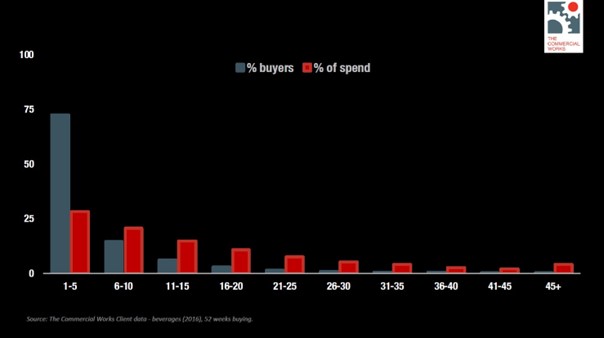 Source: Wiemer Snijders, presentation for AKTV conference 2019
Source: Wiemer Snijders, presentation for AKTV conference 2019On the other hand, there are only a few customers who buy products frequently (once a month or more). The result is an inverse relationship between the number of buyers and their frequency and volume of purchase. This is particularly true for high turnover categories such as packaged food, beverages or home and personal care products.
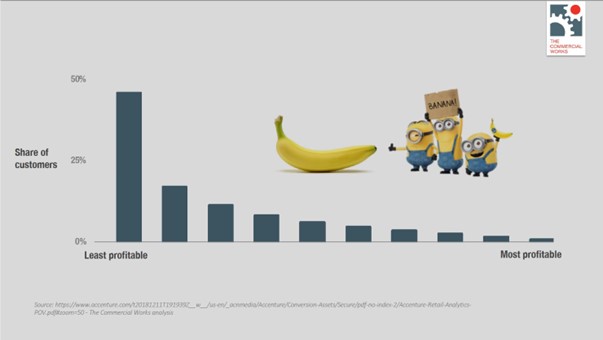 Source: Wiemer Snijders, presentation for AKTV conference 2019
Source: Wiemer Snijders, presentation for AKTV conference 2019As another example, Snijders mentioned the cosmetics brand Dove, which years ago came up with a very successful campaign depicting "normal women" instead of models in ads for shower gels and other products. This led to a 50% increase in sales over 5 years. In that period, 84% of customers bought their product only once a year (or even less).
An even bigger surprise for a brand with successful marketing and excellent distribution was that 50% of customers who buy beauty products have never bought Dove. Thus, there was still a lot of potential among customers of other brands that could be targeted.
According to the data presented by Wiemer Snijders, for the 600 brands surveyed across 40 categories, 45% of customers had purchased a brand only once and 77% had purchased it five times or less over a five-year period. These customers generated 40 percent of the brands' revenue.
MARKETING'S BIGGEST CHALLENGE: ZERO TO ONE
The biggest challenge for marketing, according to Snijders, is getting from zero to one. But most marketers focus on the right part of the banana - that is, loyal customers who buy frequently. And to find them, they invoke the mantra of using data and technology.
As an example, Snijders quotes a statement from consultancy Accenture: „After all, every dollar retailers spend on an existing customer is a sure bet against customers they don't know at all.“
„These are high-value customers who should become a retailer's latest obsession.“
But this approach would mean reversing the pattern of buying behavior - the least profitable customers would be the least and the most profitable the most.
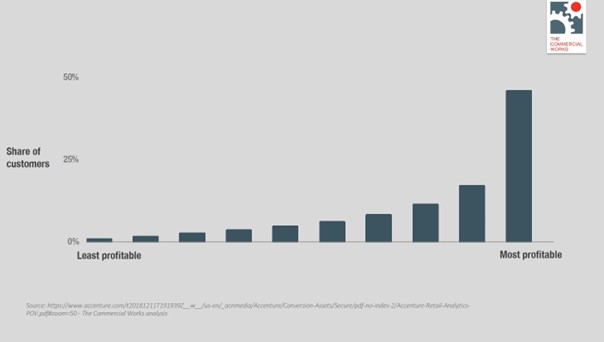 Source: Wiemer Snijders, presentation for AKTV conference 2019
Source: Wiemer Snijders, presentation for AKTV conference 2019But it doesn't work that way, as Snijders says 60 years of scientific research and data collection proves.
MARKETING EFFECTIVENESS: REACH, RELEVANCE AND RECOGNITION
Marketing effectiveness, according to Snijders, is linked to a combination of three elements: relevance, reach and recognition. It is therefore about the associations that customers make with brands, with the ability to deliver their message and to be remembered for specific brand features.
RELEVANCE: EVEN BIG BRANDS ARE ONLY OCCASIONALLY CONSIDERED BY PEOPLE
According to Snijders, it is important to realise that people don't think much about brands, they are not that relevant to them. Most of them don't even have any association with a particular brand.
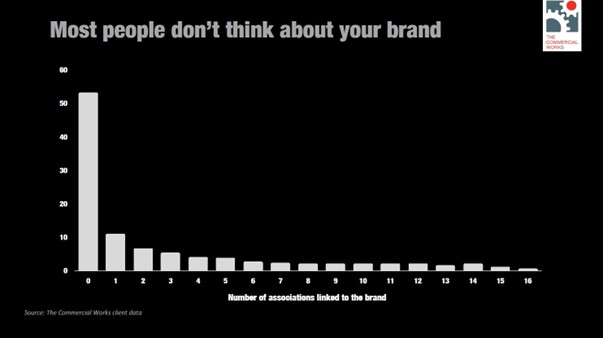 Source: Wiemer Snijders, presentation for AKTV conference 2019
Source: Wiemer Snijders, presentation for AKTV conference 2019So most associations with brands come from their current consumers. Even if you're a big brand like Coca-Cola, your customers are mostly people who occasionally think about your brand.
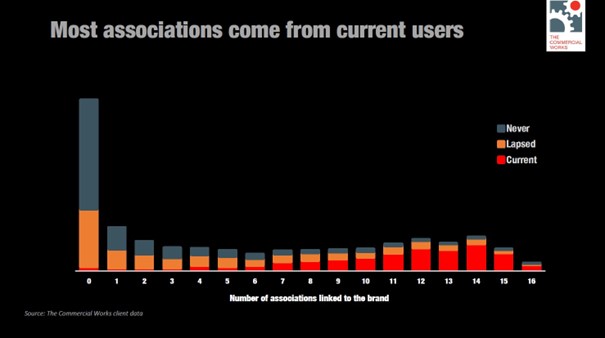 Source: Wiemer Snijders, presentation for AKTV conference 2019
Source: Wiemer Snijders, presentation for AKTV conference 2019So a big challenge in marketing communications is to reach those who don't yet have an association. Therefore, marketing communication is a long-term process that needs to be built consistently. And delivering the message to potential customers that your brand's car is safe or your brand's drink is refreshing.
But this runs counter to popular claims that data and technology are heroes because they can deliver the right message to the right audience at the right time, and that „one to one marketing will replace mass marketing.“
As we look at these new solutions, we still need to keep in mind that the pattern of shopping behavior is not changing. Snijders sees the same problem with the much popular addressable advertising on TV.
The latter, according to its proponents, „gives advertisers the opportunity to dramatically reduce wasted marketing spend by eliminating exposure to people who have no interest in their product or brand.“
„With advances in measurement, advertisers are expanding their ad lines to target specific programs that deliver higher conversions.“
This whole principle is about waste reduction and higher conversions. About the ability to reach people who are interested in the product. But Snijders isn't so sure about that. He still has “banana” on his mind and is interested in how the algorithms work. How do you know if a consumer is interested in your brand or product category?
„Let's say 7 people have a 5% chance of getting conversions, the rest have a 0.5% chance. The people on the right (5% chance) have a high chance of conversion, they are more frequent shoppers and you just need to target them with less advertising. People on the left have a low chance of conversion, they don't shop often and need to be targeted with more advertising,“ says Snijders, adding:
„And that's exactly what I mean, that we're running behind. When we prioritize addressable targeting, we focus more on the right side of the banana chart and leave out the left side. So we need to think about keeping both groups of shoppers in balance,“ says Snijders.
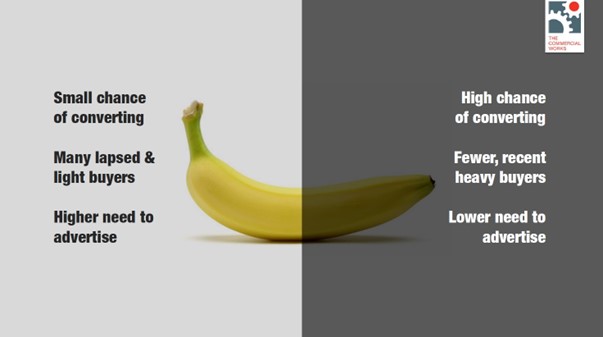 Source: Wiemer Snijders, presentation for AKTV conference 2019
Source: Wiemer Snijders, presentation for AKTV conference 2019The aim is thus to achieve a balanced communication to both customer types: on the left part are customers who buy only occasionally but who need to be targeted in the communication, on the other hand, they are less likely to convert. On the right are frequent customers who do not need to be communicated to as often. However, they are characterized by a high probability of conversion.
Another element that Snijders warns against is short-termism - focusing on short-term goals and prioritizing short-term gain. That's because multiple successes in a row in the short term may not necessarily mean that sales will thrive in the long term. Focusing on customers in the left side of the banana is just the work that requires longer-term efforts.
DOES BIG DATA HELP COMPANIES TO GROW?
In one of his comparisons, Snijders compared the results of companies that used Big Data in their marketing and those that did not. According to his findings, those that didn't use it managed to grow faster, especially in the long run.
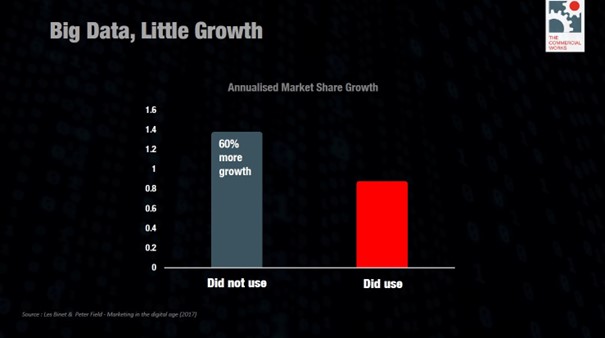 Source: Wiemer Snijders, presentation for AKTV conference 2019
Source: Wiemer Snijders, presentation for AKTV conference 2019INTERVENTION IN THE CURRENT MEDIA LANDSCAPE IS GETTING MORE EXPENSIVE
In addition to relevance, another important factor in successful and effective advertising is reach. But what we're facing in the current era, where the internet and social networks continue to rise in importance, is that the value of media spend is diminishing. This is also due to the emergence of other new media channels that initially seem cheap to use but require implementation, facilitation fees, etc. All this then makes the required intervention more expensive in the end.
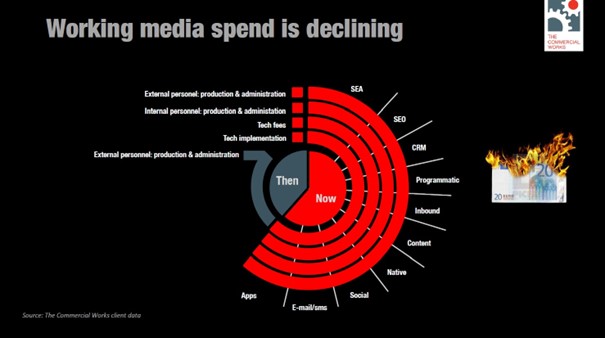 Source: Wiemer Snijders, presentation for AKTV conference 2019
Source: Wiemer Snijders, presentation for AKTV conference 2019Thus, according to Snijders, we reach fewer people at a higher cost due to the additional production costs.
THE EFFECT OF TV ADVERTISING
According to Snijders, traditional media, especially television, remains a suitable tool to reach customers located on the left side of the banana chart. Snijders compares the composition of its viewer base while watching the Super Bowl to Facebook fans in the chart.
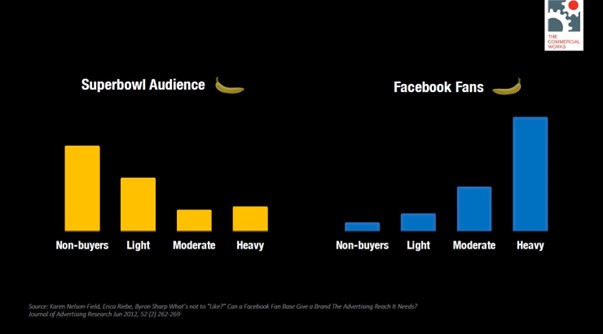 Source: Wiemer Snijders, presentation for AKTV conference 2019
Source: Wiemer Snijders, presentation for AKTV conference 2019Live TV viewership is still the most common type of viewing compared to other types of viewing (delayed TV viewing, streaming, online video). In the Netherlands in 2018, viewers watched live TV for an average of 2:05 hours per day, while they spent 25 minutes on deferred viewing and 26 minutes on streaming.
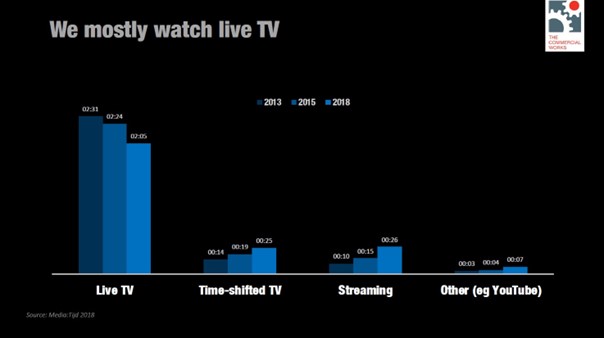 Source: Wiemer Snijders, presentation for AKTV conference 2019
Source: Wiemer Snijders, presentation for AKTV conference 2019Snijders also mentions Karen Nelson Field's research on the effect of video advertising on different communication platforms and the impact on sales of the advertised product. The highest increase in the short term is for TV advertising (up 44%), but YouTube and Facebook are not doing badly either: 37% and 21% respectively. However, a significant difference can be seen in the long term, with TV advertising generating the highest percentage of purchases of the three media. This is due to the “decay effect”, which is about 14 times slower for TV advertising than for Facebook and YouTube.
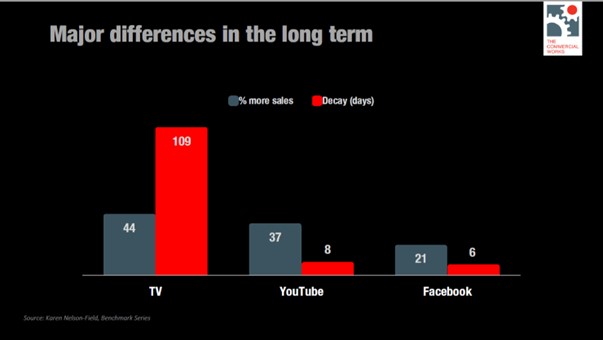 Source: Wiemer Snijders, presentation for AKTV conference 2019
Source: Wiemer Snijders, presentation for AKTV conference 2019NURTURE YOUR BRAND'S SPECIFIC FEATURES
But marketing is also about finding creative ways to make a specific brand more visible. It aims to generate great ideas and be memorable not only in the short term as we unfortunately see with most campaigns, but also to leave a long-term footprint and have some influence and impact on society. The goal is to create marketing campaigns that are flexible and playful, yet make our brands recognizable.
This is something to keep in mind when a brand is going through a rebranding process to combine the desire for change and new trends with its tradition and recognition. For example, this didn't work for the Tropicana fruit juice brand, which people associated with an orange on the packaging. The brand spent UDS 33 million on a new design, but after much criticism and rejection by customers (sales were down 20%), it eventually returned to its original visual identity.
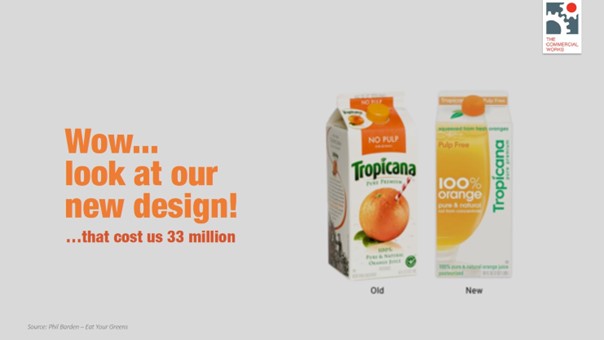 Source: Wiemer Snijders, presentation for AKTV conference 2019
Source: Wiemer Snijders, presentation for AKTV conference 2019And what Snijders advises in conclusion? Marketing is actually quite simple. All brands are like a banana. You need to be mindful of the customers who are on its left (and right, as appropriate) side. Mass media and especially television are great for reaching just the left side of customers. New technologies that enable addressable advertising on TV, for example, are fine, but there is no need to go crazy about them. It's also important to strike a balance between elements such as relevance, reach and recognition and to realise that they work best together.
Wiemer Snijders presentation on AKTV conference to be founded here.

